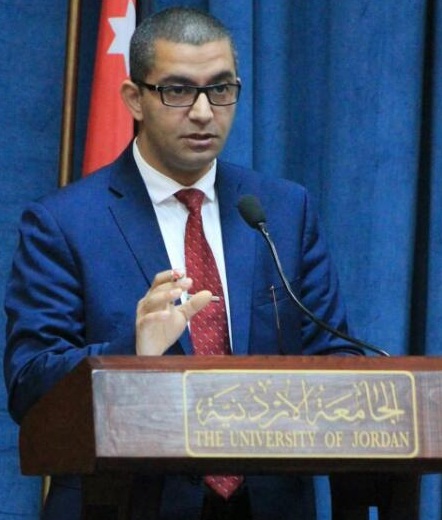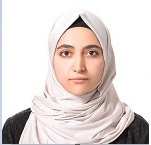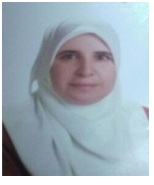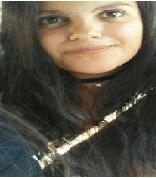As of the first semester 2016/2017, the University took the decision to pilot and implement blended learning as a strategic objective. Toward this end, it first started by training two volunteer professors (Nimer Abu Salim from the Department of English and Nour Suleiman from the Department of Linguistics) so as to start the experiment in two of their courses, to be offered in the Spring of 2016/ 2017. Prior to the training, a working definition was pinpointed for blended learning: the blending in the same course of face-to-face-education and online learning. The training, conducted by a team from the IT School in close coordination with the office of the Vice President for Humanities, took about three months and focused on both components of the blended learning approach: face-to-face meetings and online learning. The emphasis in the training was on making class meetings based on co-operative and experiential learning, and the online component on interactive learning. A lot of attention was given to the online component, especially since it is – in its interactive format – new to many professors.
After the three-month training period, in which flipped learning and project-based learning were also embedded within blended learning, the two professors were ready to embark on the journey. So, in the second semester of 2016/2017, they started the implementation. The two courses were chosen as single-section courses, and from those meeting three times a week: Sunday, Tuesday and Thursday. The formula chosen was 2+1: i.e. students will meet face-to-face with their professors, as usual, on Sunday and Tuesday (hence the 2 in 2+1) and the traditional Thursday meeting will be replaced by online activities and tasks which the students execute on their own from Tuesday night to Saturday night (hence the 1 in 2+1). The minute the professors started the implementation, they noticed the remarkable difference: the students enthusiasm for learning, the excitement about the tasks and the videos, the noticeable involvement in the chatting, etc.
There were a number of challenges to be sure: some students found it difficult to adapt at the start, as they were not used to taking ownership of the learning, especially in relation to the Thursday material; professors found the experience more demanding on them than traditional classes, as they have to think, plan, and facilitate more; and there were problems with internet access, especially on campus; etc.
However, as time went by, most of these challenges started to disappear, and the professors started reporting positive experiences and success stories.
The piloting proved to be a resounding success, and in the summer of 2016/2017, six courses were taught as blended courses. The six, all taught in the Department of English and the Department of Linguistics, proved to be a success also. In the following first semester of 2017/2018, the number of courses offered as blended jumped to 42 (67 sections) offered in nearly all humanities schools. Since then, the number has been increasing steadily across the University, including the scientific schools.
The blended learning approach has enabled the university to achieve several prime objectives at once, two of which are crucial. The first is the move from a teacher-based system of education to a student-based system, or from "teaching" and "instruction" to learning. The second is the embedding of technology in learning.
The first objective is extremely vital as most of our students come from a teaching-based system, which does not pay ample attention to higher skills: such as critical analysis, problem-solving, communication skills, etc. Switching to a learning-based system (at least in half of its processes) is a breakthrough, as students start relying on themselves and owning the learning, instead of relying on teachers.
The second objective is also of fundamental importance, as technology is an indispensable tool for the new generation, which is often described as digitally native.
It goes without saying that a system has been put in place for training, coordination, monitoring, and assessment and feedback.
As UJ has newly created a Center for Open Educational Resources, the Center is in the process of taking charge of the blended learning drive in order to augment and expand it further, as the adoption and meticulous implementation of blended learning is one of UJ's prime goals.

Testimonials on Blended Learning.
Dr. Nimer Abusalim, Department of English.
They say ‘it takes two to Tango’. Our performance and enthusiasm as teachers relies, in part, on who we are teaching and how engaged with the class they are. In the traditional method, class engagement is rarely available, and even those students who are normally considered ‘good’ students quickly lose enthusiasm for class. Who wouldn’t when every class starts with “please open your books to page…”. Blended learning, on the other hand, creates a more student-centered learning environment. Imagine the liveliness created in the classroom when students take the lead and, at least, prepare the material necessary for the next class beforehand, then come to class to ask questions and engage in discussions, all the way having their professor guide their learning process step-by-step. My students have creatively come up with their own theories and novel ideas, challenging their textbooks with knowledge they acquire from a plethora of information from open sources on the internet. Whether we like it or not, this is the age of information, and we are no longer the only source of that information. Sure, blended learning requires more work from the students and the teacher, but the benefits drastically outweigh the challenges, if any, and it gets much easier with time. Students no longer wait until the night before the exam to learn everything, just to forget most of it after the exam, because they are actively learning every week with their own style and at their own pace. I cannot imagine ever going back to the traditional method. We still have a lot to learn, but at least we took a step in the right direction. I thank our dear university, in general, and Prof. Ahmed Majdoubeh, in particular, for setting the stage and facilitating the means for this revolutionary shift in learning.

Student 1:
Eman Sari Al-Drous.
English Language and Literature department.
I am proud to say that I have taken four blended learning courses in the English Language and Literature department. What is extraordinary about these four courses is that there is one day off a week, which gives us students the chance to study and follow up at our own pace. Having a blended learning class means less time spent commuting, and more time spent studying. This great style of teaching made us more aware of self-motivation and time management skills. The thought-provoking idea of blended learning classes, initiated in our university, has made us eager to learn new things and introduced to us a new way of gaining knowledge. Ever since, we know the difference between learning and teaching, and now we would choose to learn rather than to be taught and spoon-fed. Blended learning classes with Dr. Nimer Abusalim, for example, helped us in thinking deeply and scientifically; as hisrole was more like a mentor who guided us to the right path by posting questions for discussion on e-learning. Moreover, the classes lent a hand to shy students who could not express themselves easily, and gave them a unique comfort zone to discuss and answer questions without pointing their mistakes out by giving them the chance to submit their answers online, and then in the class by mentioning their points so that they get the needed courage to express themselves in front of other students, as participating would be easier for them after knowing that their points are valid. I would be glad to take the chance and quote from my favorite writer, T.S. Eliot, who once said: only those who will risk going too far can possibly find out how far one can go. At first, some students thought that this blended learning thing was too far-fetched, but what they were ignorant about is that we found, in our blended learning classes, a teacher who was more than patient, and was enduring of our weakness and inexperience in different topics. We were given the time and the space to discuss and ask different related topics, because preparing beforehand at home has helped us in thinking, questioning, and not expecting to have a couple of slides that need to be memorized without any self-investigating. In Dr. Nimer's blended learning classes, we have an active role, and that is what makes gaining knowledge the best reciprocal anda more exciting process.

Student 2:
Heba Marwan Mahmoud AlMadhoun.
Third year student in the Applied English Department.
When I first heard the term ‘student-centered learning’, I thought that we will be studying by ourselves, submitting assignment that the professors upload for us online, and coming to class prepared for exams, without the professor helping us or explaining the material required. All the students were absolutely frightened and worried about their grades. However, I decided to give it a shot and my experience was a total success. I was submitting before the deadline and had to check for new assignments, which made me realize the value of time and taught me time-management skills. It helped me attend class fully-prepared and motivated. The teacher is no longer a teacher, but a facilitator and I, as a student, became more self-reliant; searching for information on my own and not having the professor spoon feed us every word, therefore, having the information stored and not easily forgotten. It made me a competent student and encouraged competition as I always tried to be the first student to submit assignments and score the best grade.

Student 3:
Tala Ahmed Radhi
Second year student at the Applied English Department
Welcome to the future! No, we’re not talking about flying cars so don’t get too excited. We are talking about blended learning. As a lazy student, it’s a miracle for me not to go to university every day, and learning in my PJs at home in a cozy room is way more comfortable and beneficial, I believe. This is so because you don’t have to waste your time with transportation and can focus without being interrupted by anyone or anything.
Student 4:
Leen Abusalim
English Language and Literature Department
As a student of English Language and literature at the Foreign Languages Faculty reading and analyzing texts are inseparable and essential parts of our lives. So using the traditional methods of teaching is a bit boring because as a student you do not have any resources to study from except your book, and using the spoon feeding process makes you rely on the professor all time, regardless of what type of learner you are. On the other hand, the blended learning method helps you to activate your audible and visual faculties through the usage of audios, videos, or any written reliable resource in order to grasp the required material. Also, you will not accumulate the whole material till the exam’s day because you are already updated on the material weekly on e-learning platform, so all you need is to briefly revise it before the exam. Personally speaking, once Professor Nimer Abu Salim asked me to write this testimonial I did not hesitate to present this enjoyable and beneficial experience, which helped me to enrich my ability to search and learn. So if you are a student and you want to expose a new learning methodology do not think twice about the enrollment in blended learning courses.

Dr. Hiyam Al-Zidaneen
Islamic Banking Dep. School of Sharia'
“The E-learning system is best suited for everyone. It offers individuals the privilege to take lessons at the time that suits them, depending on their availability and comfort. e-Learning is a way to provide quick delivery of lessons, as compared to the traditional teaching method. It enables Teachers to easily convey lessons in a consistent way for their targeted audience. Since individuals have different learning abilities, learners can work at their own pace instead of following the whole group. This learning mode ensures that all learners receive the same type of training according to their capabilities.
It is also time and cost effective, it saves time and transportation expense, as students do not need to go to class or purchase course materials. Students can also choose to study specific and relevant areas of their course material without focusing on each area.”
Dr. Mohammad Rayyan,
Department of European Languages.
I have always had the aspiration to develop my teaching style so that I can improve students’ performance in learning a foreign language and concentrate more on practical intelligence. Therefore, I decided to attend a Blended Learning (BL) course to try a new strategy of learning to achieve my goal. The continual support I received from the facilitators helped me to clearly understand the importance of active learning in class and how BL can best be implemented to relate theory to practice to reach a high level of learning and compete for jobs at the international level.
I began using the new style of teaching with “Spanish Language 1 for Beginners”. In the first two weeks, the students resisted the idea due to anxiety that is feltwhen trying something new. I stirred to reduce this anxiety by encouraging them to break down barriers with the new method of learning and compare their actual situation with the wonderful experiences of BL in another institution of the global level. Now, my students and I enjoy BL so much that we would find it difficult to go back to face to face (F2F) style. For me, BLin our institution will be the point of departure of a whole lifelong approach teaching.

Student 1:
Yara Jihad Masadeh
Department of European Languages.
For me, starting university was a bit scary; new people, new environment that can leave you wandering around in fear. Luckily I was enrolled in a class that uses this technique of studying which helped me to ease my anxiousness.
I am not going to lie, I was a little skeptical at the beginning, but as I learned its rules and how it really works, I started to enjoy it and wait in excitement for the next week to learn more and do various versions of homework.
According to my experience, I think one of the most useful traits of this system is that you get to learn and study about a subject beforehand and then going to class in full confidence knowing and participating with satisfaction.

Student 2:
Sara Al-Hmoud
Department of European Languages.
Blended Learning has been the guiding light through my journey in the university. It showed me how motivated and determined I can be in my studies no matter how much work I had to do, because in the end, knowing that I am capable of depending on myself makes me willing to do even more and more. It also gives me a sense of security to know that I have a consistent source of information and that I do not have to resort to anyone other than myself or my instructor.

Student 3:
Hamza Younis.
Department of European Languages.
Blended Learning taught me a lot of things, like self-confidence.
Now I can search for the information by myself not just from my teacher, and taught me "in my life" how to have confidence in myself to stand in front of my classmates to share my thoughts with any fear, also I can study from one place in my laptop or my phone because the information will be there in a one website.
It makes me study step by step, but how? every week I have assignment and it has a deadline, in this way I am forced to do it.
Student 4:
Farah Jarrar.
Department of European Languages.
Blended learning is a wonderful experience for me. It gave me the chance to explore and taught me how to depend on myself, it increased my love for self-knowledge-seeking.
Also, Blended Learning gave me courage to break the barriers between me and my instructors, gave me confidence in myself and offered a consistent base of information to always go back with the guidance of my instructors.
Lastly, it allowed me to feel like a family with classmates and professors.
Blended learning in physical education school
Dr .Aida Alawamleh, Physical Education.
Technology is almost in every aspect of our lives; therefore, the use of a virtual learning environment which provides the opportunity to deliver blended learning approaches that combine mixes of Information and Communication Technology with various delivery methods and media. The University of Jordan offers a number of courses which incorporate blended learning with contact classes and online component on an E-learning Moodle.
The Blended program consists of six distinct types: (face- to- face (driver content mostly delivered traditionally ), rotation (student rotate between online and traditional content on fixed schedule), flex (content delivered online with traditional sessions provided as needed online lab sessions offered online at a traditional –location )self –blend student chooses to take online course to supplement traditional learning , and online driver (lessons delivered mostly online with some voluntary or traditional application. Horn & Staker (2011). Blended learning is a formal education program in which a student learns at least in part through online delivery of content and instruction with some element of student control over time, place, path, and/or pace. It is typically consist of 30 to 79 percent of online content delivery
A blended learning environment at the University of Jordan is designed to provide the student with an opportunity to gain or enhance self –study.
In 2017 the University of Jordan modified a physical education module to where it can be presented with a virtual learning environment. I implemented blended learning on Motor learning course for undergraduates for sixteen weeks. I found that Students were satisfied with blended program and online learning environments; satisfaction was generally high with 83.4 percent.
Blended learning in sport sciences provides the perfect combination of online and traditional content on fixed schedule which is ideal for those balancing their studies alongside other professional or sporting commitments. Students put their theory into practice through applied studies and measurement, Sports-specific modules. Furthermore blended learning program provides opportunities to develop student management skills in motor learning and understanding knowledge and self -study